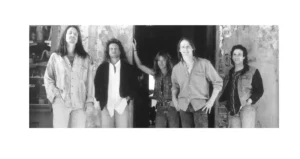Ian Anderson (born August 10, 1947) is a Scottish musician, singer, songwriter, and flautist best known as the lead member of the progressive rock band Jethro Tull. Anderson’s distinctive style and the fusion of rock with folk and classical elements have made him a significant figure in rock music.
Formation and Country:
- Full Name: Ian Scott Anderson
- Country: United Kingdom
- Formed: Anderson formed Jethro Tull in 1968 in London, England.
Biography:
Early Life: Ian Anderson was born in Edinburgh, Scotland. He developed an interest in music at a young age, initially playing guitar before taking up the flute, which would become a defining feature of his musical career.
Jethro Tull Formation: In 1968, Anderson formed Jethro Tull with a lineup that initially included guitarist Mick Abrahams, bassist Glenn Cornick, drummer Clive Bunker, and keyboardist John Evan. The band’s early sound was rooted in blues, but they quickly began incorporating elements of folk, classical, and progressive rock.
Career with Jethro Tull: Under Anderson’s leadership, Jethro Tull released a series of influential albums, characterized by their complex arrangements, eclectic influences, and Anderson’s distinctive vocal style and flute playing. Key albums include:
This Was(1968) – The band’s debut album, featuring a blues-rock style.Stand Up(1969) – Marked the beginning of the band’s shift toward a more progressive sound.Aqualung(1971) – Often considered one of their most iconic albums, featuring tracks like “Aqualung” and “Locomotive Breath.”Thick as a Brick(1972) – A concept album presented as a single continuous piece of music.A Passion Play(1973) – Another ambitious concept album, known for its intricate structure and themes.Songs from the Wood(1977) – Featuring a more folk-oriented approach.
Solo Career: In addition to his work with Jethro Tull, Anderson has pursued a solo career, releasing albums that explore a range of styles and themes. Notable solo albums include:
Walk into Light(1983) – Anderson’s debut solo album, which includes a mix of rock and synthesizer-based tracks.The Secret Language of Birds(2000) – A solo album featuring a blend of folk, rock, and classical influences.
Recent Work: Anderson has continued to perform and record, both with Jethro Tull and as a solo artist. He has also been involved in various projects, including reissues of classic Jethro Tull albums and new recordings.
Full Discography:
With Jethro Tull:
This Was(1968)Stand Up(1969)Benefit(1970)Aqualung(1971)Thick as a Brick(1972)A Passion Play(1973)War Child(1974)Minstrel in the Gallery(1975)Songs from the Wood(1977)Heavy Horses(1978)Stormwatch(1979)A(1980)The Broadsword and the Beast(1982)Crest of a Knave(1987)Rock Island(1989)Catfish Rising(1991)J-Tull Dot Com(1999)The Jethro Tull Christmas Album(2003)Homo Erraticus(2014)
Solo Albums:
Walk into Light(1983)The Secret Language of Birds(2000)Rupi's Dance(2003)Thick as a Brick 2(2012) – A sequel to the original Thick as a Brick album.
History and Evolution:
Early Work: Jethro Tull’s early work was rooted in blues, but the band’s sound quickly evolved to incorporate elements of folk, classical, and progressive rock. Anderson’s innovative use of the flute and his distinctive vocal style set the band apart.
Progressive Rock Era: The early 1970s were a particularly influential period for Jethro Tull, with concept albums like Thick as a Brick and A Passion Play showcasing Anderson’s ability to blend complex musical structures with literary and philosophical themes.
Later Years: In the later decades, Jethro Tull’s sound continued to evolve, incorporating elements of rock, folk, and classical music. Anderson’s solo work has explored a range of styles, including folk, rock, and experimental music.
Recent Work: Anderson has remained active both with Jethro Tull and as a solo artist, continuing to perform and record new material. He has also been involved in reissues and special projects celebrating Jethro Tull’s legacy.
Interesting Details:
- Distinctive Style: Anderson’s use of the flute and his unique vocal style have been central to Jethro Tull’s sound, setting him apart from other rock musicians.
- Concept Albums: Jethro Tull is known for its ambitious concept albums, which often explore complex themes and narratives.
- Influence: Anderson and Jethro Tull have had a significant influence on the progressive rock genre, inspiring countless other musicians and bands.
Music Themes:
- Conceptual and Literary: Anderson’s lyrics often explore complex themes, including mythology, literature, and philosophy.
- Folk and Classical Influences: Jethro Tull’s music frequently incorporates elements of folk and classical music, reflecting Anderson’s diverse musical interests.
- Eclectic Style: The band’s music blends various genres, including rock, jazz, and progressive elements, creating a distinctive and innovative sound.
Ian Anderson’s contributions to rock music, particularly through his work with Jethro Tull, have solidified his place as a pioneering and influential artist in the progressive rock genre.




